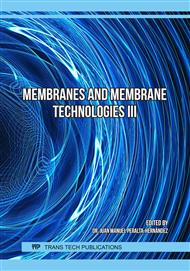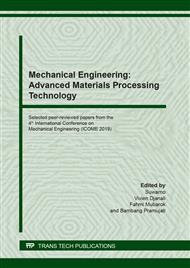[1]
A. L. Ahmad, J. Sugumaran, and N. F. Shoparwe, Antifouling Properties of PES Membranes by Blending with ZnO Nanoparticles and NMP–Acetone Mixture as Solvent,, Membranes (Basel)., vol. 8, no. 4, p.131, (2018).
DOI: 10.3390/membranes8040131
Google Scholar
[2]
CNN Indonesia, PBB: Dunia dalam Bahaya Krisis Air Global,, CNN Indonesia, p.1, (2018).
Google Scholar
[3]
R. B. Fitradi, Preparasi dan Modifikasi Membran untuk Pengolahan Air,, no. 10, p.1–15, (2015).
Google Scholar
[4]
G. dong Kang and Y. ming Cao, Application and modification of poly(vinylidene fluoride) (PVDF) membranes - A review,, J. Memb. Sci., vol. 463, p.145–165, (2014).
DOI: 10.1016/j.memsci.2014.03.055
Google Scholar
[5]
J. P. Méricq, J. Mendret, S. Brosillon, and C. Faur, High performance PVDF-TiO2 membranes for water treatment,, Chem. Eng. Sci., vol. 123, p.283–291, (2015).
DOI: 10.1016/j.ces.2014.10.047
Google Scholar
[6]
S. Gee, B. Johnson, and A. L. Smith, Optimizing electrospinning parameters for piezoelectric PVDF nanofiber membranes,, J. Memb. Sci., vol. 563, no. February, p.804– 812, (2018).
DOI: 10.1016/j.memsci.2018.06.050
Google Scholar
[7]
C. Zhao, J. Xue, F. Ran, and S. Sun, Modification of polyethersulfone membranes - A review of methods,, Prog. Mater. Sci., vol. 58, no. 1, p.76–150, (2013).
Google Scholar
[8]
S. Mallick, Z. Ahmad, F. Touati, and R. A. Shakoor, Improvement of humidity sensing properties of PVDF-TiO 2 nanocomposite films using acetone etching,, Sensors Actuators, B Chem., p.408–413, (2019).
DOI: 10.1016/j.snb.2019.03.034
Google Scholar
[9]
H. T. Bhatti et al., Graphene Oxide-PES-Based Mixed Matrix Membranes for Controllable Antibacterial Activity against Salmonella typhi and Water Treatment,, Int. J. Polym. Sci., vol. 2018, (2018).
Google Scholar
[10]
T. Bae, I. Kim, and T. Tak, Preparation and characterization of fouling-resistant TiO 2 self- assembled nanocomposite membranes,, vol. 275, p.1–5, (2006).
DOI: 10.1016/j.memsci.2006.01.023
Google Scholar
[11]
J. Wang, Y. Wang, J. Zhu, Y. Zhang, J. Liu, and B. Van der Bruggen, Construction of TiO2@graphene oxide incorporated antifouling nanofiltration membrane with elevated filtration performance,, J. Memb. Sci., vol. 533, no. March, p.279–288, (2017).
DOI: 10.1016/j.memsci.2017.03.040
Google Scholar
[12]
M. Safarpour, A. Khataee, and V. Vatanpour, Preparation of a novel polyvinylidene fluoride (PVDF) ultrafiltration membrane modified with reduced graphene oxide/titanium dioxide (TiO2) nanocomposite with enhanced hydrophilicity and antifouling properties,, Ind. Eng. Chem. Res., vol. 53, no. 34, p.13370–13382, (2014).
DOI: 10.1021/ie502407g
Google Scholar
[13]
S. J. Oh, N. Kim, and Y. T. Lee, Preparation and characterization of PVDF/TiO2 organic- inorganic composite membranes for fouling resistance improvement,, J. Memb. Sci., vol. 345, no. 1–2, p.13–20, (2009).
DOI: 10.1016/j.memsci.2009.08.003
Google Scholar
[14]
X. Wang, M. Feng, Y. Liu, H. Deng, and J. Lu, Fabrication of graphene oxide blended polyethersulfone membranes via phase inversion assisted by electric field for improved separation and antifouling performance,, J. Memb. Sci., p.41–50, (2019).
DOI: 10.1016/j.memsci.2019.01.055
Google Scholar
[15]
S. M. Seyed Shahabadi, H. Rabiee, S. M. Seyedi, A. Mokhtare, and J. A. Brant, Superhydrophobic dual layer functionalized titanium dioxide/polyvinylidene fluoride-co- hexafluoropropylene (TiO2/PH) nanofibrous membrane for high flux membrane distillation,, J. Memb. Sci., vol. 537, no. December 2016, p.140–150, (2017).
DOI: 10.1016/j.memsci.2017.05.039
Google Scholar
[16]
V. Vatanpour, S. S. Madaeni, A. R. Khataee, E. Salehi, S. Zinadini, and H. A. Monfared, TiO 2 embedded mixed matrix PES nanocomposite membranes: Influence of different sizes and types of nanoparticles on antifouling and performance,, Desalination, vol. 292, p.19– 29, (2012).
DOI: 10.1016/j.desal.2012.02.006
Google Scholar
[17]
H. Rawindran et al., Simultaneous separation and degradation of surfactants laden in produced water using PVDF/TiO 2 photocatalytic membrane,, J. Clean. Prod., vol. 221, p.490–501, (2019).
DOI: 10.1016/j.jclepro.2019.02.230
Google Scholar
[18]
M. L. Luo, J. Q. Zhao, W. Tang, and C. S. Pu, Hydrophilic modification of poly(ether sulfone) ultrafiltration membrane surface by self-assembly of TiO 2 nanoparticles,, Appl. Surf. Sci., vol. 249, no. 1–4, p.76–84, (2005).
DOI: 10.1016/j.apsusc.2004.11.054
Google Scholar
[19]
C. S. Ong, W. J. Lau, P. S. Goh, B. C. Ng, and A. F. Ismail, Preparation and characterization of PVDF–PVP–TiO2composite hollow fiber membranes for oily wastewater treatment using submerged membrane system,, Desalin. Water Treat., vol. 53, no. 5, p.1213–1223, (2015).
DOI: 10.1080/19443994.2013.855679
Google Scholar
[20]
M. Safarpour, A. Khataee, and V. Vatanpour, Effect of reduced graphene oxide / TiO 2 nanocomposite with different molar,, Sep. Purif. Technol., (2014).
Google Scholar




